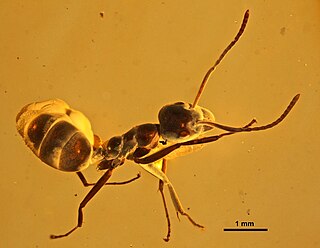
Prionomyrmex is an extinct genus of bulldog ants in the subfamily Myrmeciinae of the family Formicidae. It was first described by Gustav Mayr in 1868, after he collected a holotype worker of P. longiceps in Baltic amber. Three species are currently described, characterised by their long mandibles, slender bodies and large size. These ants are known from the Eocene and Late Oligocene, with fossil specimens only found around Europe. It is suggested that these ants preferred to live in jungles, with one species assumed to be an arboreal nesting species. These ants had a powerful stinger that was used to subdue prey. In 2000, it was suggested by Cesare Baroni Urbani that the living species Nothomyrmecia macrops and a species he described both belonged to Prionomyrmex, but this proposal has not been widely accepted by the entomological community. Instead, scientists still classify the two genera distinctive from each other, making Nothomyrmecia a valid genus.

Dolichoderus is a genus of ants found worldwide.

Yantaromyrmex is an extinct genus of ants first described in 2013. Members of this genus are in the subfamily Dolichoderinae of the family Formicidae, known from Middle Eocene to Early Oligocene fossils found in Europe. The genus currently contains five described species, Y. constrictus, Y. geinitzi, Y. intermedius, Y. mayrianum and Y. samlandicus. The first specimens were collected in 1868 and studied by Austrian entomologist Gustav Mayr, who originally placed the fossils in other ant genera until the fossils were reviewed and subsequently placed into their own genus. These ants are small, measuring from 4 to 6 mm in length and can be characterized by their trapezoidal shaped head-capsules and oval compound eyes that are located slightly to the rear of the capsules midpoint, with no known ocelli present.
Dolichoderus brevicornis is a species of ant in the genus Dolichoderus. Described by Dlussky in 2002, remains of the species were discovered in the Baltic Amber.
Dolichoderus brevipalpis is an extinct species of ant in the genus Dolichoderus. Described by Dlussky in 2008, the ant is from the Eocene epoch, being discovered in the Baltic Amber.
Dolichoderus elegans is an extinct species of Eocene ant in the genus Dolichoderus. Described by William Morton Wheeler in 1915, the fossilised remains of the species were found in the Baltic amber.
Dolichoderus granulinotus is an extinct species of Eocene ant in the genus Dolichoderus. Described by Dlussky in 2008, the species fossils were discovered in the Baltic amber.
Dolichoderus kutscheri is an extinct species of ant in the genus Dolichoderus. Described by Dlussky in 2008, the fossils of the species were found in the Bitterfeld amber, and is most likely to be from the Late Oligocene.

Dolichoderus longipilosus is an extinct species of Eocene ant in the genus Dolichoderus. It was described by Dlussky in 2002, and the fossils of the species are only known from a fossilised worker that was found in the Baltic amber.
Dolichoderus perkovskyi is an extinct species of Eocene ant in the genus Dolichoderus. Described by Dlussky in 2008, fossils of the species have been found in multiple ambers, notably the Rovno amber and the Scandinavian amber.
Dolichoderus pilipes is an extinct species of Eocene ant in the genus Dolichoderus. Described by Dlussky in 2008, fossils of the species have been found in multiple ambers, notably the Rovno amber and the Scandinavian amber.
Dolichoderus polessus is an extinct species of Eocene ant in the genus Dolichoderus. Described by Dlussky in 2002, a fossilised worker was discovered in the Rivne amber.
Dolichoderus polonicus is an extinct species of Eocene ant in the genus Dolichoderus. Described by Dlussky in 2002, a fossilised worker was discovered in the Baltic amber.

Dolichoderus punctatus is an extinct species of Eocene ant in the genus Dolichoderus. Described by Dlussky in 2008, fossils of the species were found in the Baltic Amber.
Dolichoderus robustus is an extinct species of Eocene ant in the genus Dolichoderus. Described by Dlussky in 2002, a fossilised worker was discovered in the Rivne amber.
Dolichoderus vexillarius is an extinct species of Eocene ant in the genus Dolichoderus. Described by William Morton Wheeler in 1915, a fossilised worker was found and described from the Baltic amber.
Dolichoderus vlaskini is an extinct species of ant in the genus Dolichoderus. Described by Dlussky and Perkovsky in 2002, the fossils were discovered in the Rovno amber, located in Ukraine.
Dolichoderus zherichini is an extinct species of ant in the genus Dolichoderus. Described by Dlussky and Perkovsky in 2002, the fossils were discovered in the Rovno amber, located in Ukraine.
Dolichoderus pinguis is an extinct species of formicid in the ant subfamily Dolichoderinae known from a fossil found in Asia. The species is one of a number in the genus described from fossils.

Nylanderia pygmaea is an extinct species of formicid in the ant subfamily Formicinae known from fossils found in the Prussian Formation of the Baltic region.






